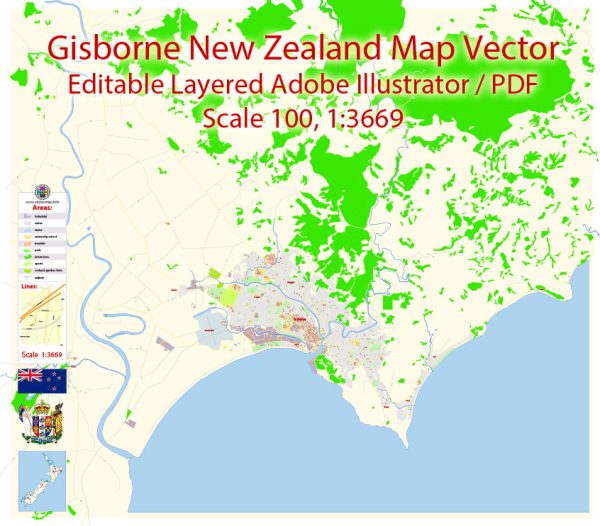Gisborne is a city on the east coast of the North Island of New Zealand.
Vectormap.Net provide you with the most accurate and up-to-date vector maps in Adobe Illustrator, PDF and other formats, designed for editing and printing. Please read the vector map descriptions carefully.
History of Gisborne:
- Gisborne is the first city in the world to see the sunrise each day due to its location on the International Date Line. It has a rich history, with significant Māori settlement before the arrival of European explorers.
- Captain James Cook first arrived in Poverty Bay, near present-day Gisborne, in 1769 during his first voyage to New Zealand. This event marked the beginning of European contact with the region.
- The city has a strong Māori cultural influence, with several marae (Māori meeting grounds) and cultural events celebrating the indigenous heritage of the area.
Transportation Infrastructure:
- Roads:
- Gisborne is accessible by road and is connected to other major cities on the North Island via State Highway 2.
- The city has a network of local roads connecting various neighborhoods and suburbs.
- Airport:
- Gisborne Airport (IATA: GIS) serves the city and the surrounding region. It is located approximately 3.5 kilometers southwest of the city center.
- The airport provides domestic flights, connecting Gisborne to other New Zealand cities.
- Port:
- Gisborne has a port that plays a crucial role in the transportation of goods. The port handles both exports and imports, contributing to the economic activity of the region.
- Rail:
- The railway network in New Zealand has historically been less extensive than road networks. While there are rail services in the country, Gisborne doesn’t have direct rail connections to major cities.
- Public Transportation:
- Gisborne has a local bus service that operates within the city and connects different neighborhoods. The extent and efficiency of public transportation services may vary.
- Cycling and Walking:
- Many cities in New Zealand, including Gisborne, have been working to enhance cycling and walking infrastructure to promote sustainable and healthy transportation options.
- Infrastructure Development:
- Like many regions in New Zealand, Gisborne has likely seen ongoing developments and improvements in its transportation infrastructure to accommodate the growing population and economic activities.


 Author: Kirill Shrayber, Ph.D.
Author: Kirill Shrayber, Ph.D.